
IntroductionOver time, the V8 engine configuration has become increasingly popular in high performance production vehicles and race cars. They have some unique characteristics, the most prominent being the very distinct exhaust sound. In this article, I will be looking in depth at the V8 engine, what makes it such a popular choice, and look at some of the shortcomings as well. Table of ContentsCylinder NumberingDifferent engine manufacturers use different cylinder numbering conventions, so to keep the article simple, I will be going with one of the most common systems, seen below. 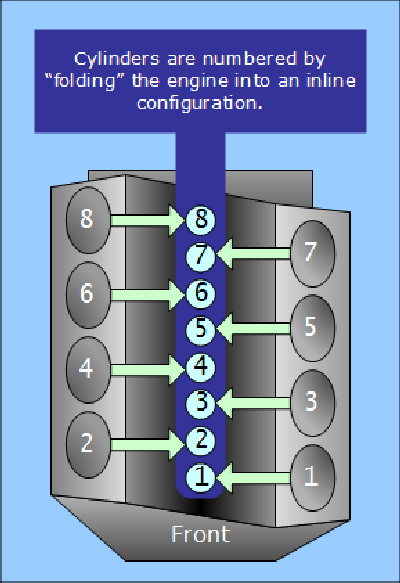
The above cylinder numbering convention is used by many auto makers on their v-type engines, including but not limited to:
V-AnglesOn a four-stroke piston engine, each cylinder fires every 720° of crankshaft rotation, so an even-firing 8-cylinder engine would have a cylinder firing every 90°. Almost all V8 engines have a 90° v-angle to achieve even firing and balance of the rotating assembly, which will be seen later in the article. TypesThere are two major types of V8 engines, which differ by crankshaft. FlatplaneThe flatplane V8 is similar to two inline four cylinders sharing a single crankshaft. When viewed from one end, the crankshaft appears to form a flat shape. 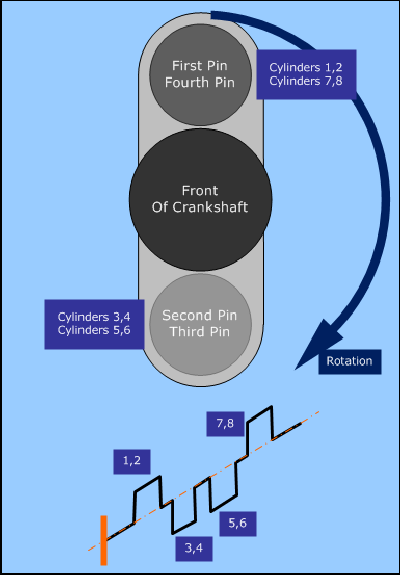
A flatplane crank with the typical 12-6-6-12 o'clock crank pin locations, when viewed from the front of the engine. This configuration is identical to an inline-four cylinder engine. CrossplaneThe other, much more common type is the crossplane V8, which Cadillac came up with in 1923. The first and fourth crank pins are 180° apart, and the inner two are 180° apart from each other, and 90° apart from the pins on each end. 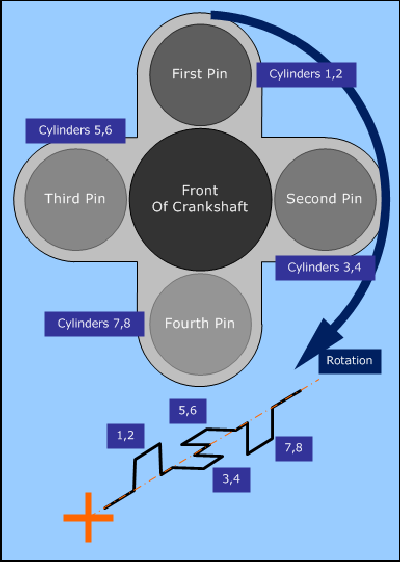
A crossplane crank with the typical 12-3-9-6 o'clock crank pin locations, when viewed from the front of the engine. BalanceFirst Order BalanceFlatplaneThe flatplane V8 has first-order balance, that is, the rocking moment that one piston would cause is directly cancelled by another at the other end of the engine. 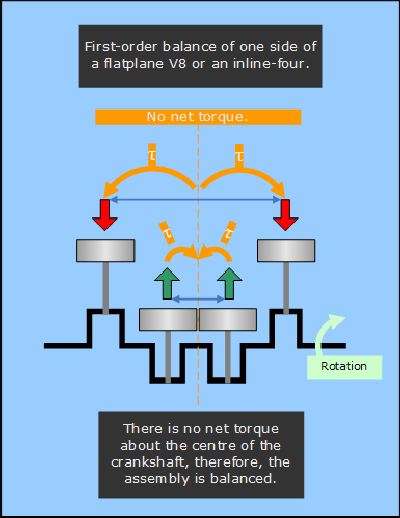
CrossplaneThe crossplane V8 would have first-order imbalance because of how the pistons are moved by the crankshaft, but the use of full-weight counterweights prevents this. 
Full-weight counterweights on the crankshaft are shaped and weighted in such a way that they counter the forces from the pistons and connecting rods on the nearest pin at the same time. Regular counterweights only counter the forces from the connecting rods and the crank pin. Only an engine with a 90° v-angle can utilize full-weight counterweights. 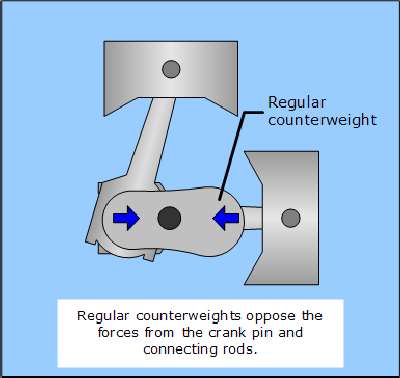
Regular counterweights only counter the forces from the connecting rods and the crank pin. 
Engines with a 90° v-angle can utilize full-weight counterweights for balance. Crossplane V8s and some 90° V10s use this configuration. Full-weight counterweights are placed on both ends of the crankshaft to oppose the rocking motion that would come from the forward most pistons moving in the opposite direction to the rearmost pistons. The middle two crank pins do not need full-weight counterweights because the piston motion forces are somewhat cancelled by the pistons on the other side of the engine. These counterweights are still very large compared to regular counterweights, however. 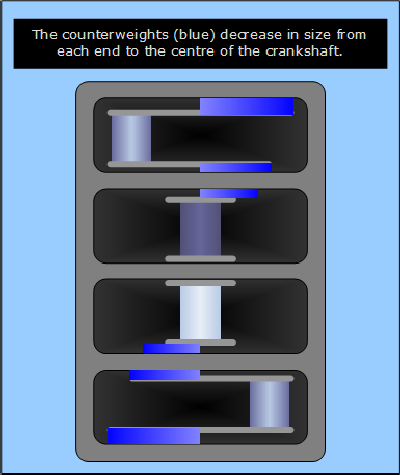
The counterweights on a crossplane V8 decrease in size from each end to the centre because the inner cylinders partially balance each other, and the counterweights on each side of a main bearing have a similar effect. The counterweights on each end must be very large because they alone are opposing the forces from two pistons and their connecting rods, and the crank pin. Second Order BalanceFlatplaneThe flatplane V8 has the same type of imbalance that an inline four cylinder does, which is known as second-order imbalance. At any given instant, the velocities of the pistons traveling upward does not equal the negative velocities of the cylinders traveling downward. The net velocity of all eight cylinders is therefore not equal to zero, which causes vibrations. 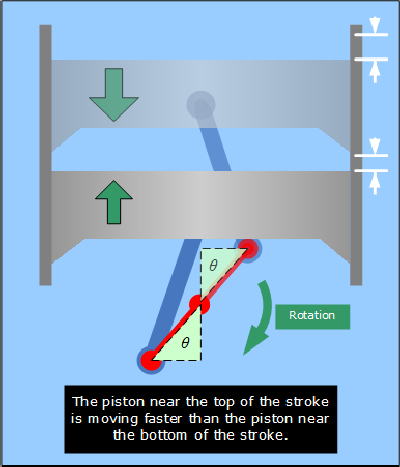
Inline-fours and flatplane V8s have second-order imbalance. CrossplaneThe crossplane V8 has second-order balance, and that fact is the main reason for its existence. The odd-looking crankshaft moves the pistons in such a way that the net velocity of all of the pistons is always equal to zero, meaning that no second-order vibrations will be present. Engines that are out of balance are somewhat limited to small displacements. As parts of the rotating assembly get larger or move faster, the vibrations they would tend to generate become stronger. Strong vibrations can cause much greater wear on all parts of the engine, and even parts of the vehicle itself. For this reason, flatplane V8 engines in production cars have not exceeded an overall displacement of around 4.5L. Crossplane V8 engines can handle any displacement; the largest regular production version being the 500CID (8.2L) Cadillac V8 built from 1970 to 1976. Firing OrdersWith so many cylinders, a V8 engine has many different firing order combinations. Some may cause less stress on the crankshaft than others, and some may allow for better breathing on the intake or exhaust sides. FlatplaneThe firing order of a flatplane V8 is ideal, that is, each cylinder in the sequence will be on the other cylinder bank from the previous. This allows the exhaust gas pressure on each side to stay somewhat even, allowing for good scavenging from the cylinders. 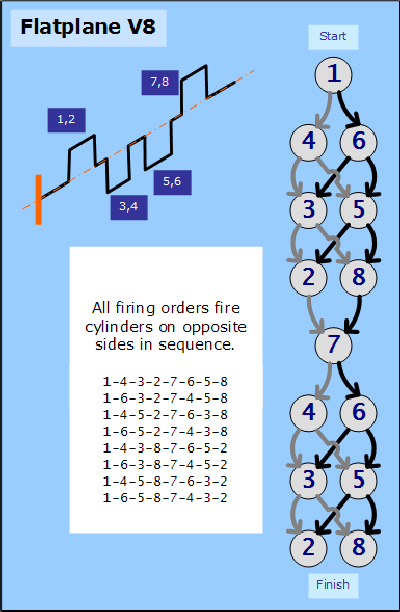
A flatplane V8 always fires a cylinder on the opposite bank during the cylinder firing sequence. CrossplaneThe crossplane V8 does not have an ideal firing order. Because of how the pistons are moved around by the crankshaft, there must always be a cylinder fired on the same side as the previous at least twice, once per bank. Not only that, but at least once in the firing order, two adjacent cylinders will fire in sequence, which is undesirable because thermal and mechanical stresses become higher at the two adjacent cylinders. 
A crossplane V8 must fire at least two adjacent cylinders during the cylinder firing sequence. With a crossplane V8, it is actually possible to fire all four cylinders on one bank in sequence, followed by all four on the other bank. These firing orders are always ignored, leaving only four practical firing order choices. Within those four, they are chosen based on which one will put the least stress on the crankshaft, and which will allow the best breathing. Below are the three firing orders that have been used on the Chevy small block engine over the years. 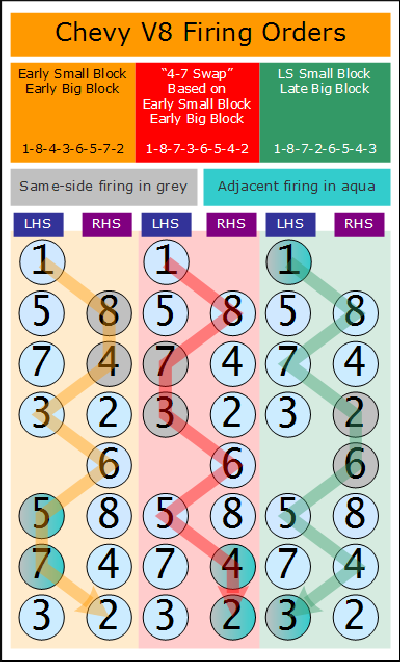
Three common firing orders for Chevy V8s. In light of the fact that Ford uses a different cylinder numbering scheme, the firing orders used by Ford are not listed in the diagrams above. Below is a digraph showing the mapping of one cylinder numbering scheme to the other. 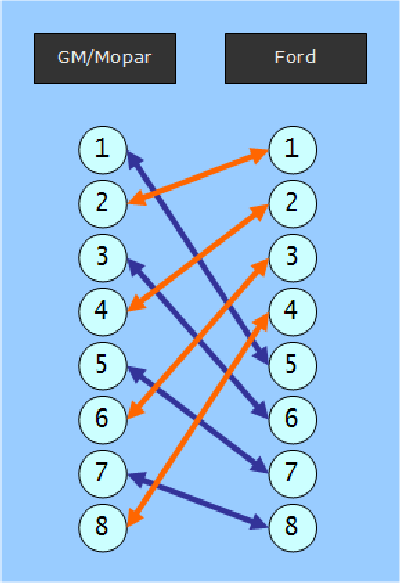
A digraph showing the cylinder numbering conversion for Chevy and Ford V8 cylinder numbers. It should be noted that the "old" Ford V8 firing order (1-5-4-2-6-3-7-8) is the same as the original Chevy small block firing order (1-8-4-3-6-5-7-2), and the "new" firing order (1-3-7-2-6-5-4-8) is the same as the GM LS series (1-8-7-2-6-5-4-3). Ford was first to make the switch in 1969, but not with all of their models. GM followed with the LS firing order in 1997. Cadillac used the LS firing order a long time ago as well, in the form of (1-5-6-3-4-2-7-8). Exhaust SoundFlatplaneThe flatplane V8 is often described as sounding similar to two inline fours running at once, although there is a slight distinction between the two which depends on the exhaust setup. CrossplaneThe very distinct exhaust sound made by a crossplane V8 is from the irregular firing order. Each time two cylinders fire on the same side in sequence, the two exhaust pulses create high exhaust pressure and noise which can be heard out the tailpipe. This repeats later in the firing order on the other side of the engine. Often times, balance pipes are used to equalize the large exhaust pressure difference between each side of the engine. The pressure equalization improves exhaust scavenging, especially at low RPM. 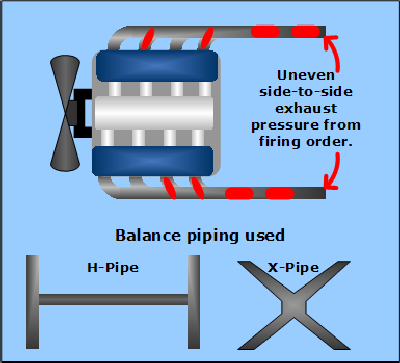
The "V8 sound" comes from the uneven exhaust pressures on either side of the engine, which is a direct result of having an odd firing order. PackagingPackaging is one of the greatest strengths of a V8 engine. When fully dressed with all accessories, a V8 engine has a roughly cubic shape, which means they fit very well in most rear-wheel drive vehicles, and even some front-wheel drive vehicles, such as the late model Chevrolet Impala SS. A V8 is slightly longer than an inline-four with a similar cylinder bore spacing, and much shorter than an inline-six. The short length puts the engine's centre of gravity well behind the front axle, which improves handling. It also allows the hood of the car to slope down at the front for improved aerodynamics. Inline-six engines, which are very long relative to their displacement, have been mostly replaced by V6 engines for the aforementioned reasons. 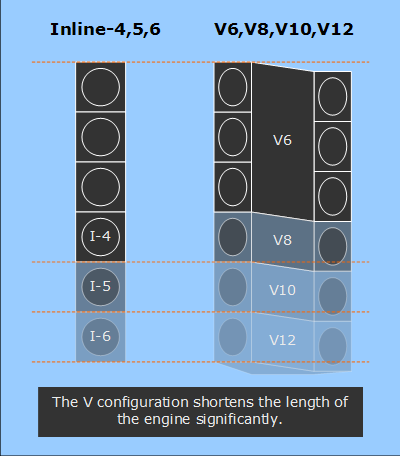
The short length of a V8 is a significant packaging advantage over a comparable inline-six or V12, which means that the V8 is essentially the smallest engine type that has first-order and second-order balance, allowing very large engine displacements, which can help give very high power-to-weight ratios. A V8 engine can still be more compact than a V12 with the same overall displacement, and has the added benefit of being cheaper to manufacture. However, a V12 of equal displacement would likely be able to make more power, at the expense of added size and weight. It is for this reason that some auto makers, such as Jaguar and Mercedes-Benz, are using supercharged V8s to achieve V12 performance with V8 size and economy. Another benefit of the short length of V8 engines is that they can be front-mounted in a car, but located entirely behind the front axle. Cars with this layout are described as having a front-mid engine (FMR) layout. 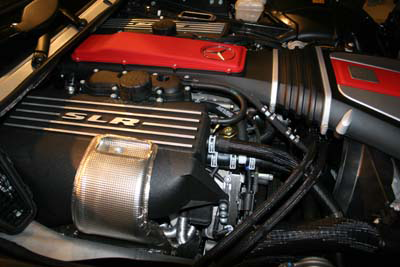
The Mercedes SLR has a front-mid engine layout through the use of a V8 engine pushed as close to the passenger compartment as possible, and a front axle that is located very far forward on the chassis. While the 90° v-angle can make a V8 too wide for use in smaller cars, the use of pushrod-actuated overhead valve (OHV) heads helps make the engine narrow enough to fit into many cars. The space and weight saved by OHV cylinder heads leaves room for a slightly larger block to provide more displacement. 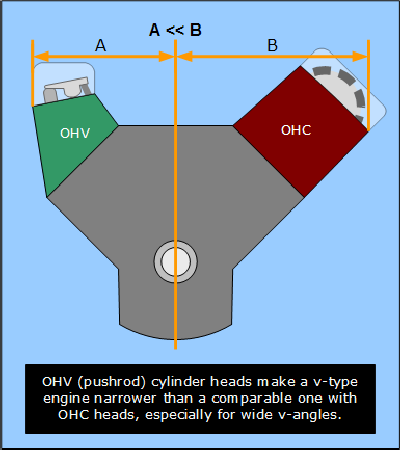
OHV heads save a lot of space on the sides of the engine. Even with narrow OHV heads, there is often little room on the sides of the engine for the exhaust manifolds. Coupled with the need for an h-pipe or x-pipe, the exhaust systems for a car with a V8 end up being a compromise between making power and keeping costs down. ConclusionThe V8 engine is a popular choice in high performance road cars and race cars because of its compact size and light weight relative to its power output. The crossplane V8's ability to support very large displacements, coupled with small, low-cost OHV heads makes it one of the most affordable high performance engine types in use today. V8 engines are also used in many luxury cars where their smooth running characteristic is an asset. The exhaust sound is considered pleasing by most people, but the uneven exhaust pressures which make the unique sound are detrimental to performance and add complexity to the exhaust system. Appendix
Related LinksV8 Church - Rover V8 Engine Parts |
||||||||||||||||||